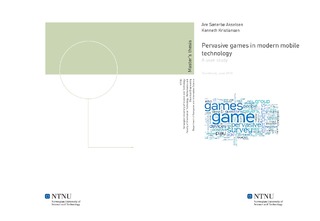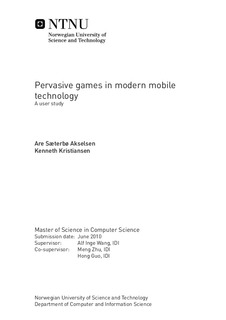| dc.description.abstract | Abstract. This master thesis presents the results from investigating usage patterns on portable devices and finding gamers attitudes towards different pervasive game elements.The main motivation of this project is to help developers create a better game experience with the use of pervasive elements and mobile technology, finding some pointers as to what players are likely to enjoy (or not). At the same time, the usage patterns will help us understand how players currently use games, which is important information creating games tailored to the players usage patterns. The results for usage patterns shows that game sessions are usually very short. We found that most people do not utilize multiplayer functionality in games on portable platforms. Investigating why players play games on portable devices, we found that quite many only use games as a secondary activity. Often, playing on portable devices are a result of some other main activity, like for example waiting for some form of transport in real life. To better understand what types of pervasive games users would be interested in, we proposed four concepts and asked the participants for their opinions of these concepts. Of the concepts proposed, the most popular concepts were one in which the game used the users geographic location to create questions from the nearby area and a concept where the game used proximity to other players as a part of the gameplay. Generally, we saw that players liked the idea of playing games with others in teams, and often as a planned event where people meet up to play.To understand what elements are likely to be successful, we studied attitudes towards the different categories of game elements. Some elements, like visual and sound feedback are staples of modern games, and therefore a necessity. Another popular output method is force feedback, in which the game shakes the controller or in other ways provide tactile feedback. Social elements were the most popular, competitive and cooperative game styles along with chat/communication abilities are important to players. Players also wish to be able to play anywhere and be able to start and stop playing at any time. | nb_NO |

